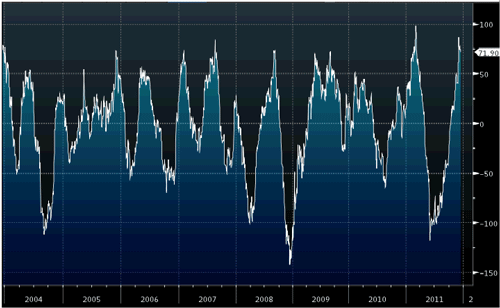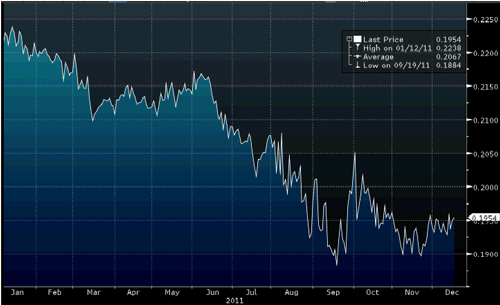In the unlikely event that ratings agencies decide to give everyone a break before Christmas, the coming week could be the start of a period of relative calm before the proverbial storm.
Yet, judging by the raft of declarations from top leaders in France, it seems highly likely that Standard & Poors’ have already given their verdict to French officials. An announcement over the coming weekend would therefore not be far-fetched, as market participants will have time to ponder the impact of the downgrades whilst markets remain closed.
In any case, nothing that was said or done over the past week would have managed to reassure rating agencies.
M. Sarkozy for one managed to exhibit once again his lack of vision and understanding of the crisis: indeed, his hints that banks could use the 3-year LTRO operations to finance sovereign debt borders on the ridiculous, whilst his call for yet another Franco-German summit on jobs and economic growth was simply useless.
Russia also did not help sentiment either by announcing that it was ready to offer USD 10 billion to the International Monetary Fund to support the European rescue. After the blank rejection from the US to participate and the untimely announcement by China of the set up of a new USD 300 billion sovereign wealth fund, this is putting the IMF rescue team on thick ice.
Hence stock prices remained under pressure for most of the week as the market priced the negative news ahead to some extent. Still whilst a loss of a triple A is never good news, it is certainly not the end of the creditworthiness of a country, as the examples of Japan and the US have shown in the recent past.
Once the news is out and the market knee-jerk is out of the way, some short term short covering might be in order in Europe. This is certainly something to keep in mind going into next week’s trading week.
From a relative play point of view, it is also worth noticing that the US market has been in good part supported by positive surprise in US figures since the late summer. However analysts may have now caught up and the cycle of positive surprise looks set to come to an end:
Citigroup Economic Surprise Index (US) – weekly data – source Bloomberg
Indeed, this is what the Citigroup surprise index for the US would seem to indicate: as can be seen from the above chart, the surprise effect works very much like a pendulum. And the pendulum is now very stretched to the positive side.
This could lead to some relative disappointments going forward for the US market especially when one considers that Europe is now trading at a 10-year cyclically-adjusted price earnings ratio of around 11 whilst the US market trades at roughly 20 on the same measure.
This shows that much bad news has been priced in by now for Europe whilst the US market may be relatively richly priced.
Although we still brace ourselves for a difficult start to the trading year in Europe, the above dynamics must be kept in mind for a swift geographical re-balancing in the not-so-distant future.
From a relative play perspective like pair trading, a cursory look at the comparative performance of the Euro Stoxx 600 index and the S&P 500 using exchange traded funds also gives an interesting perspective:
Euro Stoxx 600 ETF (STOXXIEX:xetr) over S&P 500 ETF (SPY:arcx) – daily chart
Excluding currency effects, the Euro Stoxx 600 has lost around 13% in 2011 but the relative strength of the S&P 500 looks to be potentially waning and headed for some kind of reversal. The implementation of such a strategy therefore already looks compelling.
With the above considerations in mind and a tight stop below the recent lows, the risk reward for such a trade seems attractive, especially considering the contrarian nature of the idea.
- English (UK)
- English (India)
- English (Canada)
- English (Australia)
- English (South Africa)
- English (Philippines)
- English (Nigeria)
- Deutsch
- Español (España)
- Español (México)
- Français
- Italiano
- Nederlands
- Português (Portugal)
- Polski
- Português (Brasil)
- Русский
- Türkçe
- العربية
- Ελληνικά
- Svenska
- Suomi
- עברית
- 日本語
- 한국어
- 简体中文
- 繁體中文
- Bahasa Indonesia
- Bahasa Melayu
- ไทย
- Tiếng Việt
- हिंदी
Equity Markets Brace for a French Downgrade
Published 12/16/2011, 11:11 AM
Updated 03/19/2019, 04:00 AM
Equity Markets Brace for a French Downgrade
Latest comments
Loading next article…
Install Our App
Risk Disclosure: Trading in financial instruments and/or cryptocurrencies involves high risks including the risk of losing some, or all, of your investment amount, and may not be suitable for all investors. Prices of cryptocurrencies are extremely volatile and may be affected by external factors such as financial, regulatory or political events. Trading on margin increases the financial risks.
Before deciding to trade in financial instrument or cryptocurrencies you should be fully informed of the risks and costs associated with trading the financial markets, carefully consider your investment objectives, level of experience, and risk appetite, and seek professional advice where needed.
Fusion Media would like to remind you that the data contained in this website is not necessarily real-time nor accurate. The data and prices on the website are not necessarily provided by any market or exchange, but may be provided by market makers, and so prices may not be accurate and may differ from the actual price at any given market, meaning prices are indicative and not appropriate for trading purposes. Fusion Media and any provider of the data contained in this website will not accept liability for any loss or damage as a result of your trading, or your reliance on the information contained within this website.
It is prohibited to use, store, reproduce, display, modify, transmit or distribute the data contained in this website without the explicit prior written permission of Fusion Media and/or the data provider. All intellectual property rights are reserved by the providers and/or the exchange providing the data contained in this website.
Fusion Media may be compensated by the advertisers that appear on the website, based on your interaction with the advertisements or advertisers.
Before deciding to trade in financial instrument or cryptocurrencies you should be fully informed of the risks and costs associated with trading the financial markets, carefully consider your investment objectives, level of experience, and risk appetite, and seek professional advice where needed.
Fusion Media would like to remind you that the data contained in this website is not necessarily real-time nor accurate. The data and prices on the website are not necessarily provided by any market or exchange, but may be provided by market makers, and so prices may not be accurate and may differ from the actual price at any given market, meaning prices are indicative and not appropriate for trading purposes. Fusion Media and any provider of the data contained in this website will not accept liability for any loss or damage as a result of your trading, or your reliance on the information contained within this website.
It is prohibited to use, store, reproduce, display, modify, transmit or distribute the data contained in this website without the explicit prior written permission of Fusion Media and/or the data provider. All intellectual property rights are reserved by the providers and/or the exchange providing the data contained in this website.
Fusion Media may be compensated by the advertisers that appear on the website, based on your interaction with the advertisements or advertisers.
© 2007-2025 - Fusion Media Limited. All Rights Reserved.
